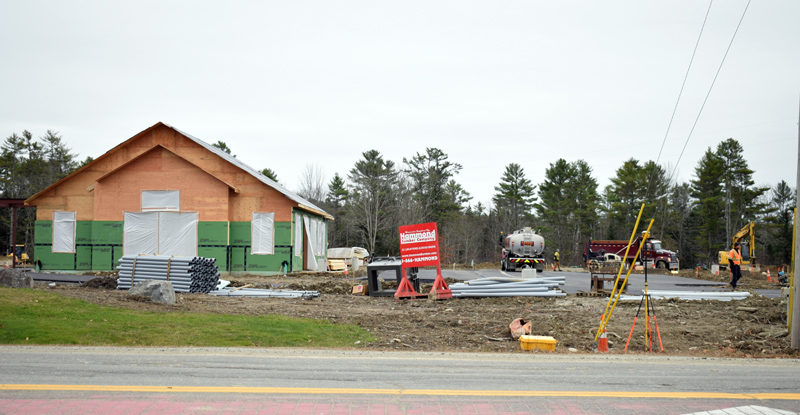
Construction continues at the future home of Camden National Bank, 435 Main St., Damariscotta, Monday, Nov. 11. Damariscotta plans to create a tax increment financing district encompassing the development. (Evan Houk photo)
Damariscotta plans to create a tax increment financing district that encompasses the new Camden National Plaza development at 435 Main St.
Under Maine law, a TIF district allows a municipality to take property tax revenue from new development in a certain geographic area and place it in a special fund for investment in infrastructure and economic development to serve the district.
The Damariscotta Board of Selectmen directed town staff to create the TIF district after a workshop Wednesday, Nov. 6.
The rise of total property value in a town as the result of a major development causes towns to pay more in county taxes and receive less in state revenue in the form of education subsidies and state-municipal revenue-sharing.
The new tax revenue from the TIF district is sheltered for up to 30 years from educational subsidy and revenue-sharing calculations, as well as county taxes.
Therefore, the town can use the new tax revenue without being penalized for its increase in property valuation through the loss of state funds or an increase in county taxes.
According to Town Manager Matt Lutkus, the current value of the land at 435 Main St. is $228,000. The taxes on the property are $3,716.
An estimated increase in valuation to $2.5 million within the next two to three years, as the property is developed, would generate an additional $36,579 in annual tax revenue for the town, Lutkus said.
According to developer Daniel Catlin, CEO of Commercial Properties Inc., construction is proceeding as planned and according to schedule.
The structure of the future Camden National Bank branch is up and granite curbing and a roof will be installed next week. Crews will work on the exterior over the next few weeks, Catlin said.
Damariscotta intends to use TIF funds for the construction of a sidewalk and possible bike path on Main Street.
“This is a public safety project necessitated by the development of the proposed district as a major retail, restaurant and office center. The public infrastructure project will also boost the economic development potential of the upper Main Street corridor,” Lutkus wrote in an email.
Lutkus, in the email, said the eventual plan is to connect the new Main Street sidewalk to the sidewalk that ends at Rising Tide Co-op, the sidewalk the developer will build at 435 Main St., a sidewalk that has been funded but not yet built at the corner of Biscay Road and Main Street, and the sidewalk built by Coastal Rivers Conservation Trust next to Great Salt Bay Community School.
The selectmen agreed they did not see any downside to creating a TIF district. They will take formal action regarding the TIF district at their Nov. 20 meeting.
The deadline for formal designation as a TIF district is March 1, 2020. The creation of the district must be approved by voters, so a special town meeting is tentatively scheduled for Feb. 19, 2020. A public hearing will be held prior to that.
The town will then submit a plan to the Maine Department of Economic Development for final approval. Lutkus said the town is working closely with officials from the Department of Economic Development and will receive the state’s blessing before the special town meeting.
Lincoln County towns with TIF districts include Boothbay, Edgecomb, Waldoboro, and Wiscasset.
Boothbay has multiple TIF districts. One includes the Boothbay Harbor Country Club and Boothbay Industrial Park, while others encompass the East Boothbay shipbuilders Hodgdon Yachts and Washburn & Doughty.
The Edgecomb district includes the Water’s Edge event center and surrounding development on Davis Island. Wiscasset’s encompasses the Rynel Inc. manufacturing facility.
Waldoboro has the newest TIF district in Lincoln County, encompassing the Route 1 commercial and industrial areas, the business park off Winslows Mills Road, and other areas with development potential.



